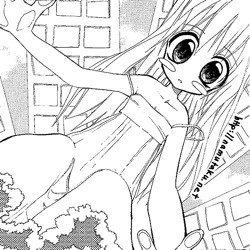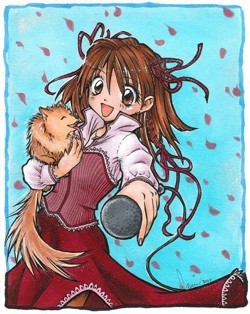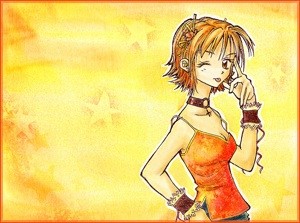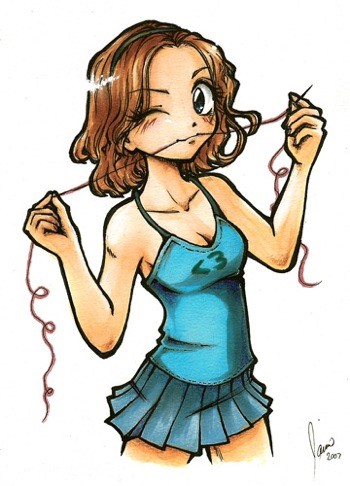The Gallery in Japan - Jamie Lano
by Evan Miller,As I put the finishing touches on this week's column, I am sitting between two room parties as a conga line of cosplayers passes my room in the hall.
Yup, it's convention season again.

For our second special column, we meet an artist who made headlines when it was announced publicly that she is an assistant for the new Prince of Tennis manga.
 |
Five years ago, Washington native Jamie Lano was preparing to finish her coursework in Animation at the Art Institute of Phoenix and was experiencing an all-too familiar feeling for many students in the United States: senioritis. Although she enjoyed Animation as a discipline, she felt like a job in the field - where she would be required to play a role in someone else's creation and not her own - would not suit her desire to make a more meaningful contribution to the art world. Unsure of what step to take next, she decided to take a year-long trip to Japan to work as an English Teacher. The goal, as she saw it, was to clear her head so she could prepare to take steps toward a new career.
Five years later, Jamie still finds herself in Japan, spending ten days (or more) in a studio with other artists, drawing manga and eating from the same four restaurants every day. It may not sound glamorous, but for Jamie, it's like a dream come true. The work is strenuous, but as an assistant for Takeshi Konomi's New Prince of Tennis manga, Jamie has finally found a job that has set her on the path she started searching for half a decade ago. "It's hard work, and although there is stress, we do have fun," says Jamie, who first started working with "Konomi-sensei" late last year. The job requires a lot out of Jamie and the other assistants, who complete their work during stays of ten days or more at a studio. Aside from sleeping and meals, all time at the studio is spent working, which means that sometimes Jamie and her coworkers will spend 16 hours a day working. Understandably, it's the kind of job that can make other parts of life difficult. "It's really hard to make plans ahead of time," says Jamie, who also cites the lack of food options and the claustrophobic studio settings as reasons why the job can be tough. Still, she is more than happy to deal with the less-than-desirable conditions to have the opportunity to work with Konomi and gain experience as an artist.
 |
Comitia Cut Art |
Jamie's road as an artist has been a long one, made up of artistic influences from western animation as well as Japanese manga. "Ever since I could hold a pencil, I've been drawing," admits Jamie, who first envisioned her attention to detail guiding to her a career in art or archaeology. As she was growing up, Jamie first took an interest in serialized Disney shows such as Rescue Rangers and TaleSpin. In high school, she took on a whole different group of influences, including the Elfquest series and Sailor Moon, which she cites as one of the things that spurred an interest in manga. Inspired to get her own work into the public eye, Jamie began working on a storyline for a webcomic. However, time and logistics got the better of her, and a busy schedule meant that she was unable to publish the work.
Although she was unable to launch a webcomic as she had hoped, Jamie kept developing her style on her own by sketching stuff in personal notebooks. Following her exposure to Sailor Moon, she continued to explore the world of manga and developed an appreciation for a wide variety of genres and styles. "I read a lot of shōjo, like Marmalade Boy and anything by Yuu Watase," says Jamie, who cites Full Moon wo Sagashite author Arina Tanemura as the biggest influence on the way she draws shōjo style characters. It wasn't long before she also took an interest in shōnen and seinen manga as well. For Jamie, the portrayal of characters in Masakazu Katsura's I"s manga, specifically females, became one of the things that helped show her the potential manga held. "[I"s] was superb... realistic, but still like manga," says Jamie. "Tanemura's style has big eyes, and that sort of thing has a place, especially for a younger audience - but for older audiences, something more detailed like Katsura's style just works better." In terms of storytelling, Naoki Urasawa's 20th Century Boys and the work of Inio Asano (Solanin) helped inspire a deeper, more involved feeling to Jamie's personal work. Although many of the manga creators that Jamie follows have inspired her, she is quick to mention that the works she is a fan of have taught her that developing a personal style is key to being a good artist. In her own words, "Tanemura and Asano all have distinctive styles, and I wanted to create that kind of a personal style in my own work."
 |
Iwao Junko Sketch |
Inspired to pursue a future in art, Jamie enrolled in the Media Arts and Animation program at the Art Institute of Phoenix with the hope of learning how to make 2-D animation. The program did have a number of benefits, including the opportunity for Jamie to work on life drawing and character poses. Still, even though she completed the coursework with little difficulty, it wasn't long before she realized that the field of animation didn't offer much creative control. Realizing that the chance to make her work come to life in the world of animation was slim at best, Jamie decided to head for Japan. Upon arriving in 2004, she took a job at an English school - a common line of work for foreigners in Japan - and soon got tired of it. The job offered very little in the way of creativity and inspiration, and the fact that Jamie didn't have a base of friends in Japan yet made things even harder. Fortunately, nine months after she took the job, she was able to move on to a new one - this time, teaching English to elementary school students. The new job, while a lot more fun, was also strenuous, and it still lacked the kind of qualities that Jamie sought. She got another step closer with another teaching job, this time at DHU, an art school in Akihabara. While she was still an English teacher, the presence of artists and an art focus helped rejuvenate her senses. Despite all the problems she faced, in the four years Jamie had spent in Japan working, she built up a group of friends and only went back to the United States to visit twice.
Jamie's big moment came in the fall of 2008, when her friends pointed her to an article online that mentioned that Prince of Tennis creator Takeshi Konomi was looking for assistants for a yet-to-be-announced project. The advertisement mentioned that Konomi didn't mind if the assistants on his project were newbies or not, which meant that someone without professional experience - like Jamie - could apply. Under pressure from her friends, Jamie applied, figuring that, at the very least, she could perhaps meet Konomi himself. "I thought that they might think, 'Hey, who's this person? We really want to meet her!'" says Jamie, who was required to draw two pages from volume 27 of Prince of Tennis for the application. She mailed it in, expecting to hear nothing - which certainly explains her shock when she got a call just three days later. The caller was an editor from Jump Square, who asked Jamie in an answering machine message if she could come in for a "trial session." Shocked, Jamie found herself avoiding the calls out of nervousness. She finally answered, and agreed to come in for a trial. In the end, less than two weeks past between the time Jamie submitted her work until the time she was heading to Chiba City to meet with her potential future employer.
 |
At work in the studio |
The first hurdle for Jamie, of course, was nerves - a hurdle that the editor made all the more difficult when they said Konomi himself would be picking her up from the train station. Jamie describes the meeting between the two was a contrast of sorts. Konomi kept asking Jamie questions, chatting, and cracking jokes while Jamie's heart raced at "a million miles an hour," as she puts it. After he asked Jamie about her interest in Prince of Tennis and favorite character from the series, Konomi told her that she would be working on a new chapter in the series, appropriately titled New Prince of Tennis. After Jamie overcame her nerves, she was instructed by Konomi himself on how to use many "tools of the trade," such as the various pen nibs and tips that artists use for lines and definition. At first, she struggled with the new media and was worried that she might be let go from the project. On the contrary, Konomi saw potential in Jamie, and she was invited to be one of his assistants for the actual run of the manga.
Despite the non-stop work, the 16-hour work days and the decrease in pay, Jamie admits that the environment she works in is surprisingly low-stress - a factor she mainly credits to Konomi. She describes the Prince of Tennis creator as a passionate artist who knows the importance of a sense of humor: "He works quickly and is very passionate about his own characters. He likes to make jokes, which keeps the work environment friendly." According to Jamie, Konomi's friendliness tends to affect the rest of the workplace just as much. Even though there is little privacy and deadline crunching is part of the production hassles, the staff are all friendly with one another and mistakes are approached with laughter, not punishments. In one instance, Jamie was adding tennis racquets an image where the character's arms were already in the picture. She added the racquets, but forgot to fill in the arm again to make the picture look natural. As a result, the image looked as if one character had wrapped his racquet - and arm - around another character. Upon reviewing the image, Konomi simply laughed and said, "The fans will definitely notice THIS one!" Jamie talks about the incident as one of the reasons she plans to stick with this job as long as she can. "Had [that accident] happened in some other job," she recalls, "I would have been upset. Instead, we all just laughed and I fixed it. This is hard work, but we do have fun." Not only has the job been rewarding, Jamie has noted that the job has helped her improve both her background drawing skills and her Japanese skills.
 |
While Jamie is quite happy working with Konomi-sensei, the project has ironically helped her accomplish what she set out to do after college: find her path. "I really want to debut [with my own series]," says Jamie, who is hoping that her future work can weave together the kind of all-audiences storylines that made manga so compelling to her. She's found that her skills are in demand other places as well; she's currently writing a monthly column for the Asahi Weekly, and is also part of a new TV show called Asahi Pop and Press, which begins airing in April. The program, which features locations in Tokyo of interest to foreign visitors, is aimed at a younger audience and is geared towards helping young viewers understand other cultures. The show is part of another long term goal for Jamie: use her unique position to help foster understanding amongst people. "I want to do something that helps people understand the motivations of people who are not like them," says Jamie, who also began volunteering at a Tokyo soup kitchen for the volunteer group Second Harvest Japan last month. "I think manga can reach anyone - all walks of life, so I hope that I can use that to help foster understanding." Regardless of what the future holds for Jamie, what can be said for certain is that she's found her path - and it leads up. Her advice to other people who want to follow her footsteps? "You need to be in Japan," she says with a smile. "My advice is simple: come here, study Japanese, and when you apply, don't be discouraged. Just believe in yourself, and do it."

 |
Jamie with Takeshi Konomi |
ANN: Tell us about your original project Denki ga Kieta Sekai. What is the story about, and what inspired it?
Jamie Lano: It's set in a post-apocalyptic Akihabara. Right now, it's just a short story that I'm writing in order to send to a publisher and try my luck at making a debut. Beyond that, I don't want to give away the story, so you'll just have to wait! It wasn't inspired by any one thing, aside from the fact that I used to work in Akihabara, and I've always been fascinated with a post-apocalyptic world.
ANN: What are some of the things that you are currently struggling with most as an artist?
Jamie: My biggest problem right now is finding the time to work on my own projects (like Denki ga Kieta Sekai). I just don't have the time, but I need to find it in order to make my own debut as a mangaka. There are times when it can be quite frustrating, but I'm not ever going to give up!
 |
Self portrait |
ANN: You're on TV now. What do you think about the current way foreigners are portrayed on Japanese TV?
Jamie: Well, I've never really watched a lot of tv, especially recently, so I'm not sure what the current image is. If I remember right, the general image of a foreigner was that they couldn't speak japanese well and were kind of treated as a joke. But that's kind of similar to the way that most celebrities, especially japanese ones, are portrayed, so I don't really think that we (as foreigners) can really complain.
ANN: As someone who aspires to work with manga on a larger scale, how do you think the differences between how different cultures review and criticize a work of art would affect a future project of yours that was published outside of Japan as well?
Jamie: Actually, I've thought about this on and off over the time that I've spent writing Denki ga Kieta Sekai and other projects. But in the end, while I will still have multiple cultures in mind while creating a work, I don't think that I would let those thoughts affect my work. My work is about the stories that I want to tell, and I hope to stay as true as possible to that.
To see more of Jamie's work, check out her official site here. Her popular blog is located here on LiveJournal, and she also has a Deviant Art account that features her latest stuff.
Are you an aspiring manga artist looking for some extra page views? Do you have a friend or loved one who draws extremely good original manga but needs a boost? Don't just sit there! Submit two links to your work, including one original piece (no file attachments please! File attachments will be folded into an envelope, and given to senpai with a bunch of cookies... and then he'll turn me down because he's dating that other girl! WHY AM I NOT GOOD ENOUGH FOR SENPAI?!?!), to evan [at] animenewsnetwork dot com, and you could be featured in a future Gallery column!
All works © Jamie Lano.
discuss this in the forum (12 posts) |
